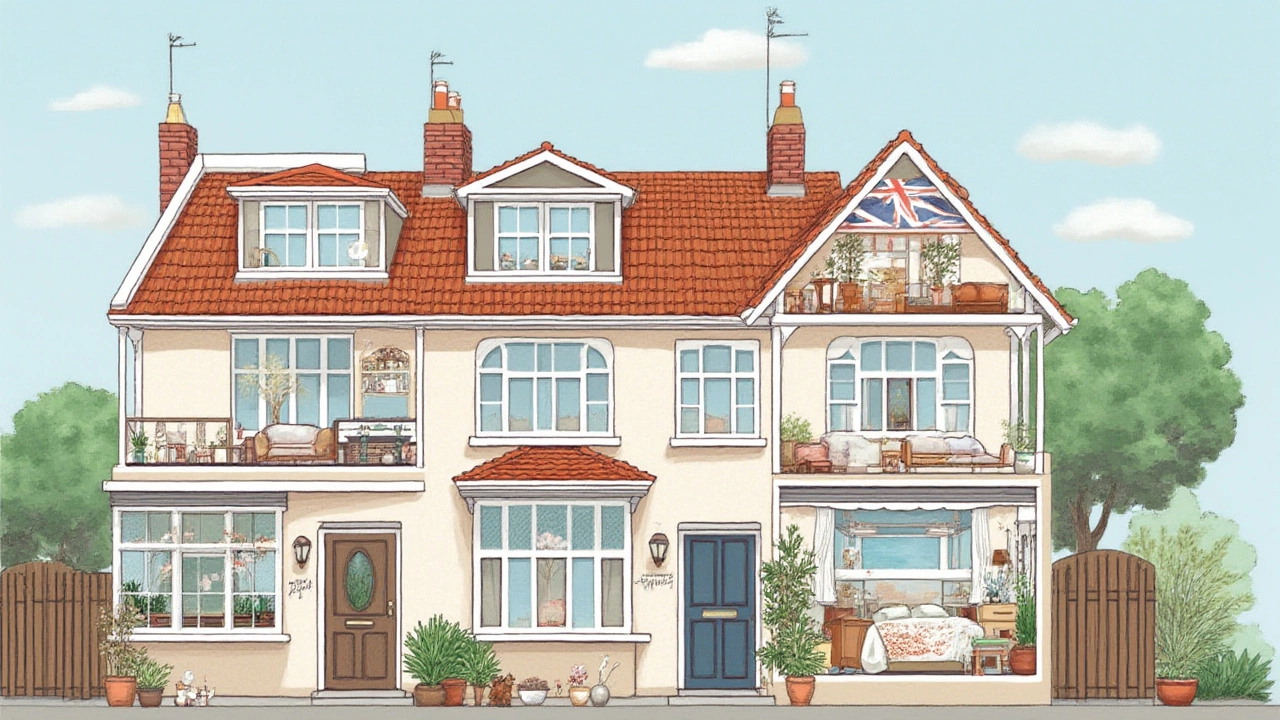If your house feels more cramped than cozy, that unused attic above your head isn’t just gathering dust—it could be your ticket to a bigger, brighter home. Thousands of UK homeowners have unlocked up to 30% more living space simply by converting their lofts. Crazy, right? One well-chosen conversion can mean the difference between a cramped two-bed and a roomy three-bed with an extra bathroom—no need for planning permission headaches or moving vans rumbling outside your door.
But here’s the rub: not every loft works with every conversion. The type you choose matters. Pick wrong and you’re stuck with weird, sloping ceilings or extra costs you never saw coming. When it comes to extending upwards, homeowners usually face four main options. Each has its own advantages, challenges, and price tag. So, what are these magical four?
Dormer Loft Conversion
The dormer loft is the undisputed classic. Picture this: a box-like structure juts out from the slope of your roof, creating headspace, light, and best of all, a proper room feel. You’ll get vertical walls and a flat ceiling where the dormer sits, which means you can squeeze in a double bed or even a decent-sized bathroom without learning acrobatics just to stand up.
What’s special about dormers? They work with most UK homes, particularly those with sloped roofs. Dormers also pump up your usable floor space, not just by a few feet, but by several square metres, especially in long Victorian terraces or smaller semis. In fact, a standard rear dormer can add 50% more usable space compared to just using the existing loft.
There are several flavours of dormer, like the flat-roofed, gabled, or hipped dormer. Flat-roof dormers are popular because they’re cost-effective and simple to build. Gabled or ‘dog-house’ dormers can look more attractive from the outside, blending in with older buildings, but they do cost more. If you want a real-life example, just wander around any London suburb—dormers pepper almost every street.
One quick tip: most rear dormers fall under ‘permitted development,’ so you often won’t need full planning permission. Just check your council’s specific rules beforehand. On cost, you’re looking at £40,000 to £55,000 for a basic single dormer with bedroom and en-suite, but bespoke designs, multiple dormers, or premium finishes push the price higher. It’s not pocket change, but it’s often way less than moving house.
| Dormer Variant | Key Benefit | Average UK Cost (2024) |
|---|---|---|
| Flat Roof | Most internal space | £40,000 - £50,000 |
| Gabled | Better curb appeal | £45,000 - £55,000 |
| L-shaped | Ideal for period homes | £50,000 - £70,000 |
If your house is in a conservation area or part of a listed terrace, though, you might face a brick wall—literally. Councils often refuse boxy dormers visible from the street, so double-check before you start picking out bathroom tiles.
Hip to Gable Loft Conversion
Not every house has a straightforward roof. If your home has a hipped roof (meaning the sides all slope inwards—think 1930s semis), a dormer might only get you so far. That’s where hip to gable conversions come charging to the rescue. This clever type of loft conversion involves straightening out the sloped ‘hip’ side of the roof and building it up vertically—to form a ‘gable.’ Suddenly, all that awkward dead space turns into precious floor area, transforming a cramped attic into a real, functional room.
Why go for hip to gable? Three big reasons. First: it maximizes space for homes where the existing loft is just too small. Second: it looks seamless, especially from ground level. You get a side wall that matches the rest of your house, keeping neighbors and planning officers happy. Third: this type works brilliantly when paired with a rear dormer, nearly doubling the final floor area.
This conversion is a favorite in suburban neighborhoods where houses were built with hipped roofs to maximize sunlight and privacy. While they look elegant from the outside, hipped roofs are a pain for conversions because much of the loft is just unused slopes. By switching one (sometimes both) hips to a vertical gable, you free up loads of valuable space. Some people even combine two hips for a double hip to gable, but that’s a bigger project (and a bigger check for your builder).
Cost-wise, you’re often looking at £50,000 to £65,000, especially when paired with a rear dormer. It’s a fair jump from a basic dormer, but not surprising given the roof structure changes involved. Don’t forget: if you live in a semi-detached or end-of-terrace, you’re the perfect candidate for this conversion style. But if you’re in a mid-terrace house, you can’t add a gable where only party walls exist—nature of the beast.
One important thing: because you’re changing the roof’s outline, more councils demand full planning permission, especially for homes in built-up or protected areas. Fail to get permission and you could face a costly undo job—definitely not fun.

Mansard Loft Conversion
If you’ve ever admired those stately Georgian or Edwardian townhouses with the ‘flat-topped’ roofs and tall windows, you’ve already seen a mansard conversion. The mansard reshapes the whole side or rear slope of the roof into a near-vertical wall (usually 70-72 degrees), basically creating another full storey. Imagine a cube perched on your house—inside, you get max headroom, big windows, and a normal room layout.
This one is for ambition. Mansards can turn poky attics into full apartments, extra bedrooms, or dream studios. That’s why they’re so popular for large terrace houses and period properties, especially in dense urban spots like Islington or Camden. In fact, many homes sporting mansards were conversions from the 1970s and ‘80s, when planning rules eased up for more living space.
But nothing good is easy—or cheap. Mansards are the most dramatic and invasive option, requiring a lot of steelwork and new structural supports. They also need a complete new roof, not just a section like a dormer. All of this takes time: expect at least 10-14 weeks of building work, lots of scaffolding, and inevitable dust. That said, some families have moved out for the duration just to avoid daily life in a construction zone.
Mansards usually cost anywhere from £60,000 to £85,000, but you get what you pay for—real floor-to-ceiling rooms, lots of daylight, and proper resale value. Remember, though: this isn’t something you sneak past the council. Planners will want to see drawings, street views, and design statements. In conservation areas, you’ll face even more scrutiny—though oddly enough, old London streets sometimes require mansards to blend in. That’s regulation for you.
If you already have a high ceiling height in your existing loft (230cm or more at the center), the mansard gives you the most dramatic upgrade. Owners with growing families, live-in nannies, or the dream of an Airbnb suite tend to love this option because of its generous proportions. However, no two mansards are ever identical—each is designed around the house, street, and planning restrictions. Tread carefully with your choice of architect and builder for this one.
- Pro tip: Some luxury mansards feature balustrade terraces—check regulations, as some councils refuse ‘roof gardens.’
- Historic note: The mansard roof was first made popular in 17th-century France by architect François Mansart.
Roof Light or Velux Loft Conversion
Wish you could transform your attic with the least hassle and cost? Meet the roof light conversion (often called Velux, thanks to the famous skylight brand). Here’s how it works: instead of constructing new walls, extending your roof, or changing its shape, you simply add windows to the existing slope, beef up insulation, and install a staircase. The structure of the roof stays the same. It’s as simple—and as affordable—as a loft conversion gets.
This option shines when your existing loft space has enough headroom to begin with (minimum 2.2m is ideal) and you don’t need to add much new floor area. If your attic is already a decent size—think post-war semis and some 1990s builds—the roof light option delivers a proper room: perfect for a home office, nursery, or studio apartment. Plus, you avoid major changes to your home’s exterior. From the street, only the flush-fitting skylights give the game away.
Installation usually takes 3-6 weeks. With only minor structural tweaks, the disturbance to your daily life is minimal. As for price, you’re looking at £25,000 to £35,000—sometimes even less. That’s less than you’d pay for a new kitchen and often much cheaper than extending outwards. Around 25% of all UK loft conversions use this method.
The main limit? You’re working with what you’ve already got. If your loft has tricky low beams or isn’t tall enough at the center, you’re out of luck. The rooms tend to have sloping ceilings at each side, cutting into how you use the space. Still, clever storage (built-in wardrobes, under-eaves drawers) can make a big difference. And with modern roof lights offering blackout blinds and even remote-controlled venting, these rooms are nothing like the stuffy attics of the past.
Planning permission is usually a non-issue unless you live in a listed building or want unusually large windows. Many projects fall under permitted development, especially for smaller homes or bungalows. Always double-check if you’re near a conservation area or boundary line, though.
- Velux windows can provide up to 40% more natural light than a standard vertical window of the same size.
- Add sound insulation to the roof—skylight conversions are notorious for rain noise.
- Invest in sun protection blinds; attic rooms can blast past 30°C in summer.
For anyone who wants more usable space without breaking the bank or months of scaffolding, the roof light conversion delivers quick, impactful results.

Author
Damon Blackwood
I'm a seasoned consultant in the services industry, focusing primarily on project management and operational efficiency. I have a passion for writing about construction trends, exploring innovative techniques, and the impact of technology on traditional building practices. My work involves collaborating with construction firms to optimize their operations, ensuring they meet the industry's evolving demands. Through my writing, I aim to educate and inspire professionals in the construction field, sharing valuable insights and practical advice to enhance their projects.